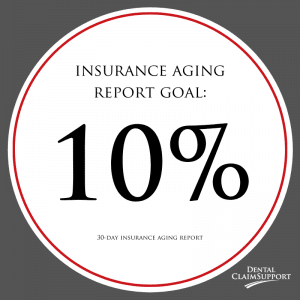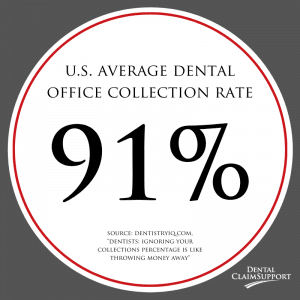What Makes a Dental Practice Successful?
.jpg)

4 Metrics to Monitor for a Successful Dental Practice
Running a successful dental practice can be challenging. Not all dentists and office managers know which indicators tell them if they are running an efficient business or one that just needs more work and guidance.
At Dental Claim Support, we have worked with hundreds of offices where the dental team simply didn’t know what they didn’t know. Because of our knowledge of all dental software reporting and effective dental principals, we know what measurables separate a well run practice from a poorly run one.
This article will explain 4 important metrics that will gauge the pulse of your practice and help safeguard for a successful dental practice.
1. Understand Your Insurance Aging Report

You should be running this report weekly if not daily. It provides you with a precise snapshot of how your office is performing specifically with claims submission and claims processing. Claims over 30 days old, your over 30-day insurance aging report, should only make up at most 10% of all claims that have been created and sent. When we refer to all claims we’re talking about your over 0 day insurance aging report.
For example, an insurance aging report totaling $100,000 should have at most $10,000 in outstanding claims of over 30 days old. These claims are usually made up of secondary submissions as well as appeals.
So, what if your aging report doesn’t fall into this favorable range of 10% and is even 30-40% or more? This is where every office needs a problem solver. Having someone researching these claims daily will make sure that nothing slips through the cracks and claims don’t age and become forgotten.
If no one is responsible for working your insurance aging report, your collections will certainly take a major hit, and your outstanding aging report percentage will continue to climb.
2. Understand Your Collections Percentage

Collection percentage is calculated by dividing your Total Collections by your Net Production ( Production – Adjustments = Net Production). The average practice in the US has a collection percentage of 91%.
What does this look like?
Well imagine that your $1 Million practice loses close to $100,000 annually to avoidable management practices. The beauty of an average is that you have the potential to be the above-average outlier. This brings me to my next point.
Your collections percentage can be in the 97-100% range if you are running a successful dental practice. Patient collections are just as important as insurance collections.
Going back to our last metric, if your aging report is favorable and your collection percentage is not, that means you have a patient payment problem that needs to be addressed, and vice versa.
3. Pay Your Providers Off Collections, Not Production
This system simply makes the most business sense. Piggy-backing off our last example, ask yourself why you would pay your providers based on 1 million dollars when you’re only collecting $900k?
Paying providers off collections brings the entire team together to focus on the same mission, to collect 100%. Each team member is held accountable. All providers are invested in the practice as a whole rather than just keeping their head down and producing crowns and cleaning teeth.
If you don’t collect it, then you don’t get paid for it.
4. Run Your Daily Deposit Report
Your daily deposit report should match exactly what’s hitting your bank account. Running this report on a daily basis is essential to know your cash flow as well as keeping clean books. This report also can help you detect embezzlement and inaccuracies in reporting before it’s too late.
If $100 shows as a credit card payment in your dental software, and you don’t have $100 deposited into your bank account, there’s a problem. This can and does happen with virtual credit cards
How Outsourcing Your Dental Billing Can Help With Collections
If you were already monitoring these metrics but still not seeing results, you may just need some extra help. It takes diligence, time, and focus to stay on top of these four business metrics and run a successful dental practice.
Achieving a high collection percentage and a favorable insurance aging report doesn’t happen on its own. As you know, finding the extra time as an office manager or the business owner/dentist can be nearly impossible.
That’s when outsourcing your billing can save your business.
Outsourcing your billing does not mean you’ll be giving up control, it’s actually the opposite. It allows your in-house office manager focus to become the leader of your front desk, continue a patient-focused attitude toward the practice, and be a liaison between the practice and the billing company.
Having one set of eyes on collections, insurance aging reports, reconciliation, insurance verification, and all other administrative aspects of your practice can be detrimental to running a smooth operation.
Outsourcing your billing adds expert-level dental knowledge in the form of multiple employees working at half the cost of a front desk administrator.
Outsourced billing is:
- A write-off to your business
- A watchdog for improprieties/embezzlement
- An “employee” that never takes a vacation
- An “employee” that works while you are on vacation
- An accounting-driven accurate poster
- A bulldog who fights insurance companies to collect what you produce
Is Outsourced Dental Billing a fit for your practice
Maybe your office is performing nicely, and you feel there is no need for a change. If that’s the case, continue to focus your attention on your patients and monitor your reports for your successful practice.
Although outsourcing dental billing may not be in the interest of everyone, thousands of offices are seeing the benefits it has on streamlining their processes and increasing the bottom line.
If you feel your office could use some guidance and an extra hand, learn more and explore some more benefits of outsourcing your dental billing.
Related Posts
Dental revenue resources from Dental Claim Support

